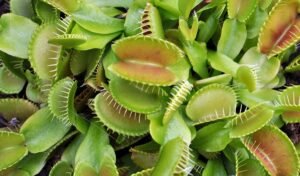Venus flytrap belongs to Droseraceae family. Scientific name of Venus flytrap is Dionaea muscipula. Venus flytrap is also called Carnivorous plant. Venus flytrap catches insects with its clamping structure such as arachnids. When the prey enters its mouth, the movement of prey creates vibrations and these vibrations are called sensitive hairs or trigger hairs. Common name of Venus flytrap reflects to Venus, the roman goddess of love and Genus name reflects Dionaea the Greek goddess Aphrodite. Venus flytraps eat different kinds of insects in which grasshoppers, spiders, flies, small frogs and beetles are included. Checkered beetles, longhorn beetles and green sweat bees are their own pollinators so they don’t eat them.
Classification of Venus flytrap
- Class Magnoliopsida
- Order Caryophyllales
- Family Droseraceae
- Genus Dionaea
- Species Muscipula
Growth of Venus flytrap
Venus flytrap grows from a bulblike rootstock. Venus flytrap are usually 20-30cm long and straight with a cluster of white flowers at the tip. Venus flytrap has blades and their leaves are 8-15cm long. Venus flytrap takes three to five years to mature. Every year the Venus flytrap blooms after plant Rex matrithe.

Habitat of Venus flytrap
Venus flytrap is found in temperate and subtropical wetlands of South Carolina and North Carolina, on the East Coast of the United States. Venus flytrap are found in moist longleaf pine savannas. For most of the year Venus flytrap is found in wet soil.
Life cycle of Venus flytrap
Venus flytrap grows in marshy areas with low nitrogen soils and they are capable of obtaining nitrogen from animals. Growing season, Dormancy, seeding and flowering are important in the phases of Venus flytrap life cycle. The life of Venus flytrap is up to 20 years. In plants, Venus flytraps are more attractive carnivorous plant. Venus flytraps get their food with arachnids and insects.
Read more about What are the neutropenic precautions?
Adaptation of Venus flytrap
Venus flytraps gather their nutrients from, where there is dust and gases in the air. They live in an environment where nitrogen is poor so they get their extra food from insects. Venus flytrap leaves are small and leaved with trigger hairs due to their toughness.
- The aromatic smell present in the leaves of Venus flytrap attracts prey.
- Trichomes or trigger hairs structures are present on the inner surface of each blade.
- In Venus flytrap edges are lined with hair like fibers, these fibers are called
Evolutionary changes of Venus flytrap
Venus flytrap has evolutionary changes that are occur due to this process, herbivores such as Dionaea muscipula aka. The evolution of Venus flytrap is from carnivorous plant about sixty five million years ago. According to fossil record, Venus flytrap ancestors flourished in Europe. Venus flytrap has snap mechanism due to this, they capture larger prey according to their body size.
Modification of Venus flytrap
The leaf of Venus flytrap is highly modified. Three hair cells are present on the upper layer of Venus flytrap. Mechano-motion detectors are present in Venus flytrap therefore they are sensitive to mechanical stimuli.
Behavioral adaptation
There are five types of behavioral adaptation.
- Altered feeding habits
- Migration
- Learned behavior
- Distinct mode of communication
- Hibernation
Conclusion
The Venus Flytrap, with its stunning carnivorous behaviour and complex trapping mechanism remains a symbol for the nature’s ability to adapt and creativity. Knowing its structure, behaviour as well as its habitat and conservation issues it faces reveals the complexity of this amazing plant.
As a testament to evolution marvels The Venus Flytrap continues to captivate people, scientists and lovers of nature from all over the world. The unique adaptations and behaviors do more than enhance our knowledge of botany, but also highlight the significance of conservation efforts in order to safeguard these amazing species and their ecosystems.
